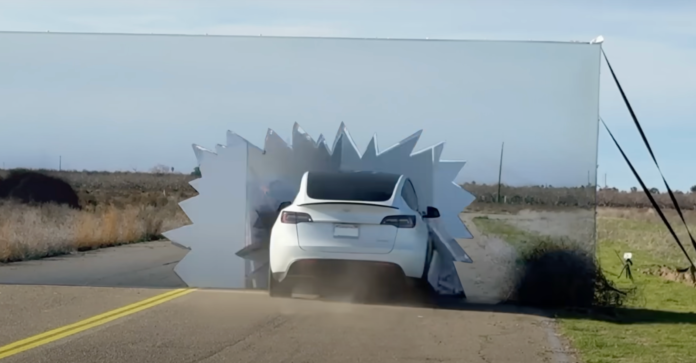Tesla Autopilot drove into Wile E. Coyote-style fake road wall in the middle of the road in a camera versus lidar test.
While most companies developing self-driving technologies have been using a mix of sensors (cameras, radar, lidar, and ultrasonic), Tesla insists on only using cameras.
The automaker removed radars from its vehicle lineup and even deactivated radars already installed in existing vehicles.
The strategy has yet to pay off as Tesla’s systems are still stuck at level 2 driver assist systems.
CEO Elon Musk claims that Tesla’s advantage is that once it solves autonomy, it will be able to scale faster than competitors because its vision plus neural net system is designed to work like a human driver and, therefore, will be able to adapt to any road.
Critics have pushed back against those claims, especially since Musk mentioned Tesla achieving “level 5 autonomy”, which means “in any conditions,” and cameras have limitations on that front that are fixed by lidar sensors.
A new video by engineering Youtuber Mark Rober has provided a very interesting demonstration of that very problem:
In the video, Rober puts a Tesla Model Y on Autopilot against a vehicle using a lidar system in a series of tests in different conditions.
The Tesla on Autopilot managed to stop for a kid mannequin in the middle of the road when statics, moving, and blinded by lights, but it couldn’t stop in fog or heavy rain:

It’s not surprising that the lidar, a laser-based system, is capable of detecting better in heavy fog than a camera system.
The heavy rain was a bit more surprising, but to be fair, the level of rain was quite spectacular.
The last scenario of a Wile E. Coyote-style wall with a fake road painted on it was obviously not realistic, but it serves to illustrate the issue with cameras versus radar or lidar sensors: they rely on the perception of potential obstacles rather than hard data about potential obstacles.
In simple words, the lidar sensors didn’t care what was painted on the wall, they only cared that it was a wall, while cameras can be tricked.
Electrek’s Take
I think it’s clear that no Tesla vehicle currently available will be capable of level 5 autonomy as Elon claimed.
Level 4 is also questionable.
I think you can accomplish a lot with cameras, but I think it’s undeniable that adding radars and lidars can make systems safer.
In DMs with us during Tesla’s transition to vision only, Elon even admitted that “very high-resolution radars would be better than pure vision”, but he claimed that “such a radar does not exist”:
“A very high-resolution radar would be better than pure vision, but such a radar does not exist.”
When we pointed one out to him, he didn’t respond. Also, while they use light rather than radio waves, lidars are basically high-resolution radars, but the problem is that Musk has taken such a strong stance against them for so long that now that they have improved immensely and reduced in prices, he still can’t admit that he was wrong and use them.


